Log in
Search
Latest topics
» Tee Dee .020 combat modelby Ken Cook Today at 3:23 am
» My latest doodle...
by batjac Yesterday at 9:47 pm
» My N-1R build log
by roddie Yesterday at 8:50 pm
» Free Flight Radio Assist
by rdw777 Yesterday at 4:51 pm
» Purchased the last of any bult engines from Ken Enya
by getback Yesterday at 12:05 pm
» Funny what you find when you go looking
by rsv1cox Wed Nov 20, 2024 3:21 pm
» Landing-gear tips
by 1975 control line guy Wed Nov 20, 2024 8:17 am
» Cox NaBOO - Just in time for Halloween
by rsv1cox Tue Nov 19, 2024 6:35 pm
» Canada Post strike - We are still shipping :)
by Cox International Tue Nov 19, 2024 12:01 pm
» Duende V model from RC Model magazine 1983.
by getback Tue Nov 19, 2024 6:08 am
» My current avatar photo
by roddie Mon Nov 18, 2024 9:05 pm
» Brushless motors?
by rsv1cox Sun Nov 17, 2024 6:40 pm
Cox Engine of The Month
a cheap sport muffler
Page 2 of 5
Page 2 of 5 •  1, 2, 3, 4, 5
1, 2, 3, 4, 5 
 Re: a cheap sport muffler
Re: a cheap sport muffler
RknRusty wrote:I'll be doing some testing on one with different pipe configurations soon. First I'll fly it with a Tee Dee on my Streak. And after the CEF Speed Freakout, I'll use it on my mustang racer for tank pressure evaluation.
Regarding the above picture, you might find it's more stable and drains the tank better if you shim the rear end of it away from the fuse so that it's oriented tangent to the circle rather than yawing out with the plane.
Rusty
OK Rus.. now that the "CEF Speed Freakout" is behind us..
Just to re-cap for anyone who missed this thread; (and not to beat a dead horse.. honestly) this homemade muffler design for Cox .049 engines is easy and cheap to make.. it's lightweight and has dozens of configurations that you can try. You can even tap it for pressure.. and make extensions to route exhaust wastes away from your model.
Materials are; x1 pc. of 1" thin-wall aluminum tubing, about 1/2" long, to form a ring.. (shower curtain-rod, etc.)
x1 sheet (2" x 4") of bicycle tire inner-tube material
A "few" (preferably a dozen) .22 cal. (spent) ammo shell-casings (get em' at your local shooting range.. they're
not re-loadable.. and people toss them) These will be your header pipe(s)
Tools needed;
*Tubing cutter (or saw) to cut the 1" aluminum thin-wall tubing to approx. 1/2" long
*a standard paper-stapler
*a 1/2" diameter round punch (make from 1/2" round thin-wall metal tubing.. approx. 2" long)
*a small wood block (for the punch)
*a 15/64" drill-bit and electric-drill
*drill bits varying in size; from .204" diameter and smaller; depending on how many different pipes you want to
experiment with. A single wide-open header-pipe has a .204" inside diameter.
If you want to make a pressure-tap, you'll also need some small metal tubing (fuel-line nipple size) and a means to flare one end. A "half-A" lead-out guide already has a flare, is the perfect length (about 1/2") and works perfectly if you already have one. Attach sm. size fuel line to run to your tank vent.
If you want to make an exhaust extension; standard "bendy" plastic drinking straws fit tightly on a .22 cal. shell-casing "header-pipe", and can be routed down and wire-tied to a l/g strut.. or along the fuse and straight out the back, keeping oil off your model.
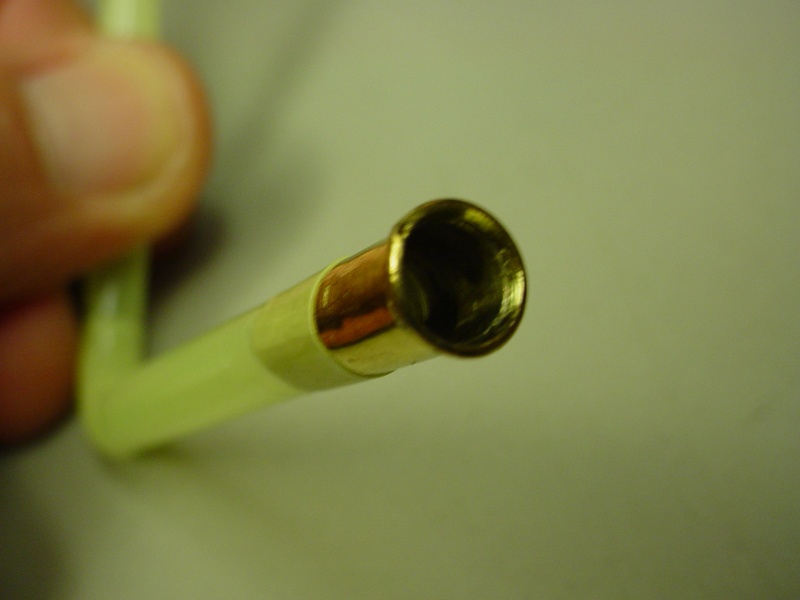
Most conventional mufflers are a compromise. This design installs/removes easily without any engine disassembly, allows for varying degrees of back-pressure by drilling different size holes in the header-pipes (which can be swapped-out quickly).. might possibly improve your stunt engine runs; through use of the pressure-tap.. and let's not forget; it will make your engine quieter.. even with wide-open headers (VS. running "open-face")
If the weather's decent tomorrow, I'll try running an engine with muffler on my dyno using an exhaust extension.. and post a vid of the results. I have one almost ready to go.
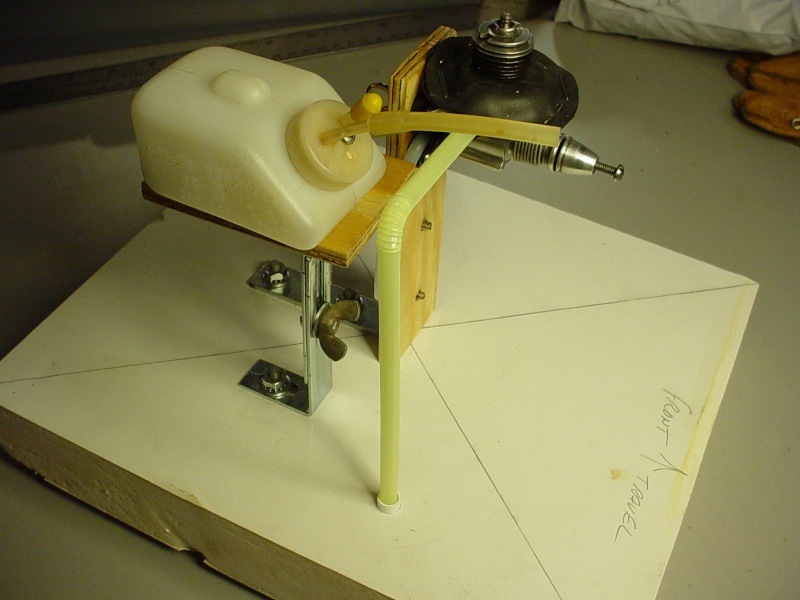
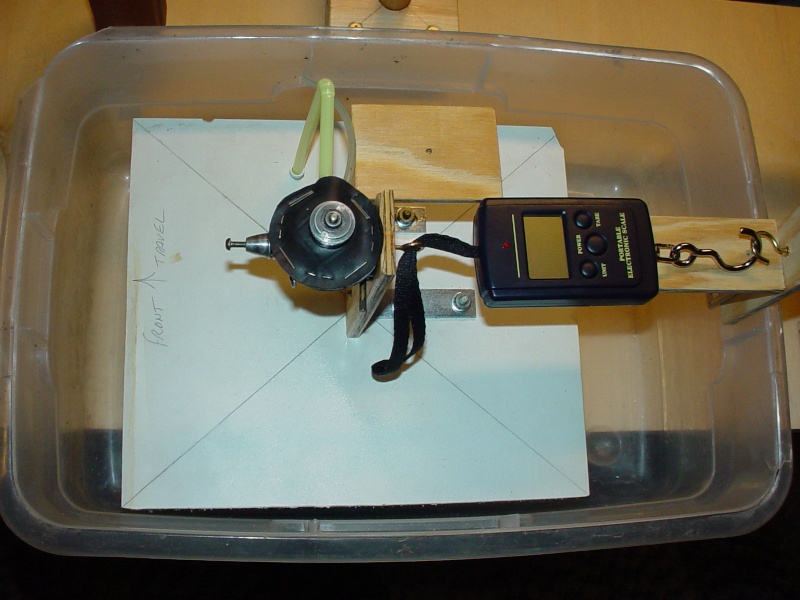
 Re: a cheap sport muffler
Re: a cheap sport muffler
That's Cool man very inexpensive way to have pressure system////the noise part or restriction of power I can do without 
 I know when I took the muffler ring off the 049 medallion made it come to life like hade not seen ...being I had not ran the only one I had no other way
I know when I took the muffler ring off the 049 medallion made it come to life like hade not seen ...being I had not ran the only one I had no other way  Thanks Roddie.....Eric
Thanks Roddie.....Eric
 I know when I took the muffler ring off the 049 medallion made it come to life like hade not seen ...being I had not ran the only one I had no other way
I know when I took the muffler ring off the 049 medallion made it come to life like hade not seen ...being I had not ran the only one I had no other way 
getback- Top Poster



Posts : 10439
Join date : 2013-01-18
Age : 67
Location : julian , NC
 Re: a cheap sport muffler
Re: a cheap sport muffler
Yeah Roddie, I'll dig up that Altoids box and give it a try. I tried to try it, but found it won't fit on a Tee Dee. I'll put one on the Reed Speed plane. At least we have a baseline for how fast it flies without a muffler.
Rusty
Rusty
_________________
Don't Panic!
...and never Ever think about how good you are at something...
while you're doing it!
My Hot Rock & Blues Playlist
...and never Ever think about how good you are at something...
while you're doing it!
My Hot Rock & Blues Playlist

RknRusty- Rest In Peace

- Posts : 10869
Join date : 2011-08-10
Age : 68
Location : South Carolina, USA
 Re: a cheap sport muffler
Re: a cheap sport muffler
RknRusty wrote:Yeah Roddie, I'll dig up that Altoids box and give it a try. I tried to try it, but found it won't fit on a Tee Dee. I'll put one on the Reed Speed plane. At least we have a baseline for how fast it flies without a muffler.
Rusty
Yea... there isn't too much clearance between the cylinder and venturi on a Tee Dee.. The rubber muffler housing is very flexible though.. and it's flap "should" flex up (or down..) and tuck in between. The inner aluminum ring is free-floating and only has a .050" wall thickness. There is the added thickness of the rubber too.. but the rubber will compress. Of course; you definitely wouldn't want to "force" it to fit. There isn't much clearance in between a reedie's needle/cylinder using a horseshoe backplate either, but the rubber flexes easily to fit with clearance to spare.
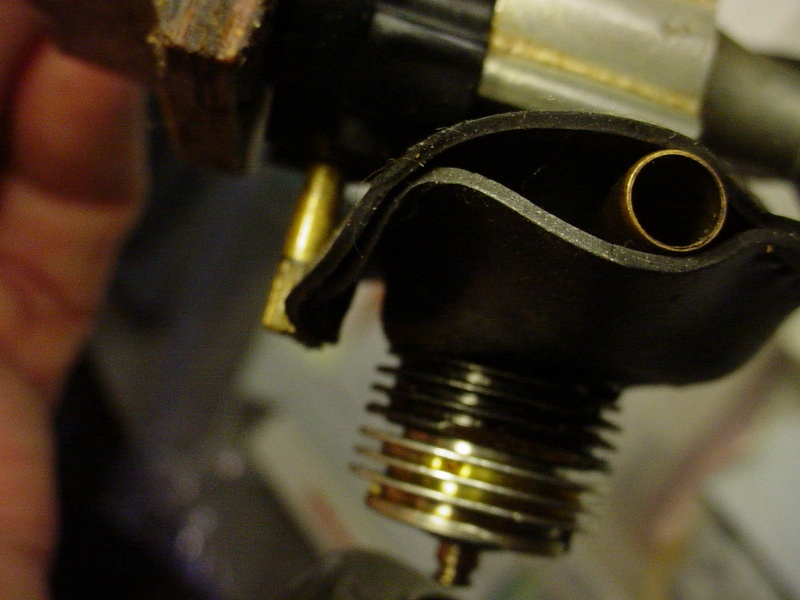
 Re: a cheap sport muffler
Re: a cheap sport muffler
Bumping this thread to show a smaller diameter muffler body (outer rubber discs) and ease of fit.
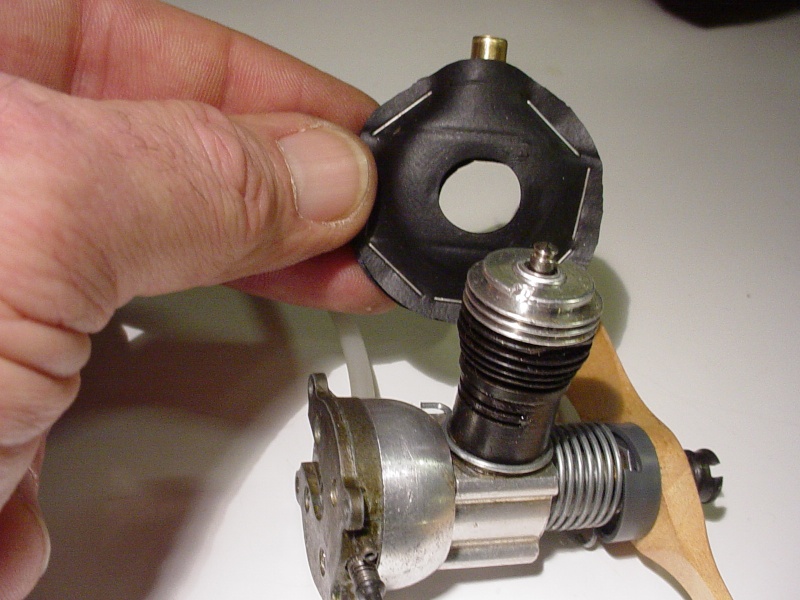


This version may fit between the cylinder/venturi on a non-SPI front rotary-valve engine.. although I don't have any Cox's to try. It has a single pipe of .205" inside diameter, which is the maximum it can be drilled-out.. and also allows for an exhaust-port prime using a short piece of small size fuel tubing on your priming bulb/syringe.. as there's no shoulder on the inside of the pipe for the tubing to catch on. Just feed the primer tube extension through the pipe until it hits the cylinder wall and give a little squirt.
The .205" pipes are naturally the least restrictive, and running duals is even less restrictive. Does anyone know the total area of the exhaust ports on certain .049 cylinders? It would be interesting to have some figures for test purposes.



This version may fit between the cylinder/venturi on a non-SPI front rotary-valve engine.. although I don't have any Cox's to try. It has a single pipe of .205" inside diameter, which is the maximum it can be drilled-out.. and also allows for an exhaust-port prime using a short piece of small size fuel tubing on your priming bulb/syringe.. as there's no shoulder on the inside of the pipe for the tubing to catch on. Just feed the primer tube extension through the pipe until it hits the cylinder wall and give a little squirt.
The .205" pipes are naturally the least restrictive, and running duals is even less restrictive. Does anyone know the total area of the exhaust ports on certain .049 cylinders? It would be interesting to have some figures for test purposes.
 Re: a cheap sport muffler
Re: a cheap sport muffler
I have Ron's fuel test Bee on a test stand ready to crank. I'll put one of your mufflers on it and see how it does.
Rusty
Rusty
_________________
Don't Panic!
...and never Ever think about how good you are at something...
while you're doing it!
My Hot Rock & Blues Playlist
...and never Ever think about how good you are at something...
while you're doing it!
My Hot Rock & Blues Playlist

RknRusty- Rest In Peace

- Posts : 10869
Join date : 2011-08-10
Age : 68
Location : South Carolina, USA
 Re: a cheap sport muffler
Re: a cheap sport muffler
Some interesting numbers on a #2 .049 engine cylinder's exhaust port area. The port-area is 0.0336" (ea. side) and a .204" ID muffler-pipe's area is 0.033"... so running dual-pipes theoretically offers near zero back-pressure.
A #3 cylinder (twin-slit exhaust ports) area is 0.0165" (ea. side) and running a single .204" ID pipe would also theoretically offer zero back-pressure.
A #1 cylinder's area is 0.037" (ea. side) and has the largest ports of any of my cylinders.
This gives a more scientific base-line for testing pipes having different size openings. For example; fitting a #2 cylinder with a single .204" pipe will create a 50% reduction in exhaust gas flow.
I used this calculator along with my vernier-calipers to arrive at these figures.
https://www.easycalculation.com/area/circle.php
A #3 cylinder (twin-slit exhaust ports) area is 0.0165" (ea. side) and running a single .204" ID pipe would also theoretically offer zero back-pressure.
A #1 cylinder's area is 0.037" (ea. side) and has the largest ports of any of my cylinders.
This gives a more scientific base-line for testing pipes having different size openings. For example; fitting a #2 cylinder with a single .204" pipe will create a 50% reduction in exhaust gas flow.
I used this calculator along with my vernier-calipers to arrive at these figures.
https://www.easycalculation.com/area/circle.php
 Re: a cheap sport muffler
Re: a cheap sport muffler
My wild Saturday night consisted of making another homemade muffler. This one is smaller still. I used the same 1.000" dia./.050" wall alum. tube (ring) on the inside.. but cut it to a length just over 5/16" (.320" to be exact..) which is about as small as I can go and still have room for drilling the holes for header pipe(s). This one is a 180 degree dual-header exit design with a pressure-tap exiting at the rear.
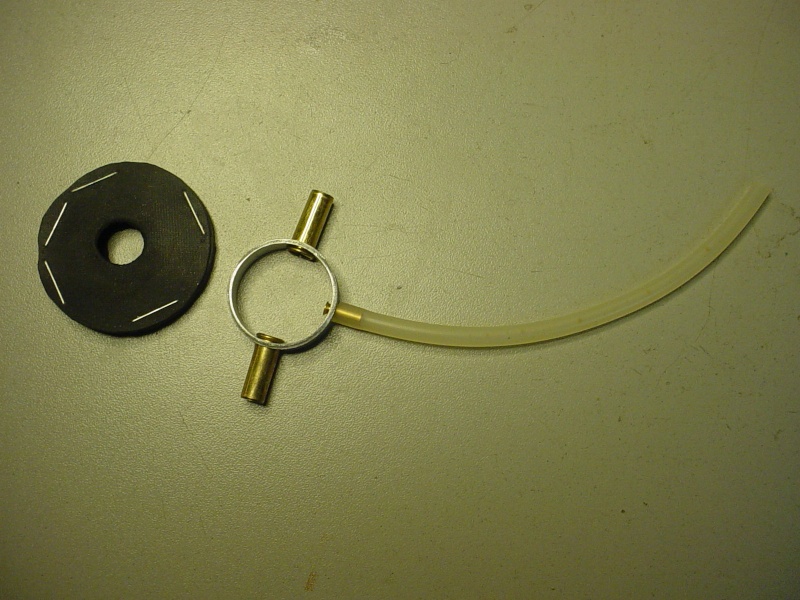
Again.. once assembled; it pushes right on over the glow-head.
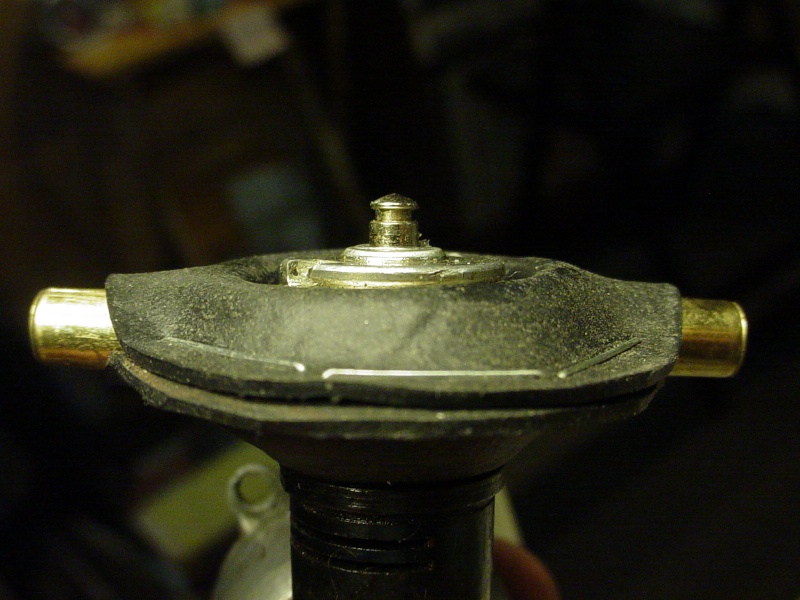
I tried a different type of rubber.. (same .040" thickness) but encountered a tear when installing the inner alum. ring. so I remade the rubber-body from inner-tube (bicycle) rubber which is very tough. The two rubber discs are 1.625" dia. and the holes in the center are punched-out 7/16" dia. They are simply stapled together around the edge.. with common paper-staples.. leaving gaps where the pipes exit.
Although shown installed on a Babe Bee, this pressure-line would run back to an external hard-tank for running a horseshoe or postage-stamp backplate.
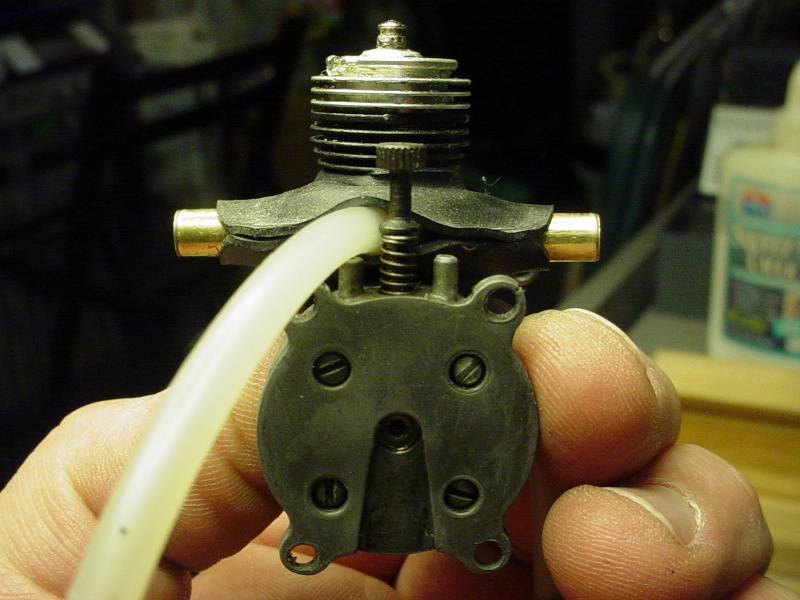
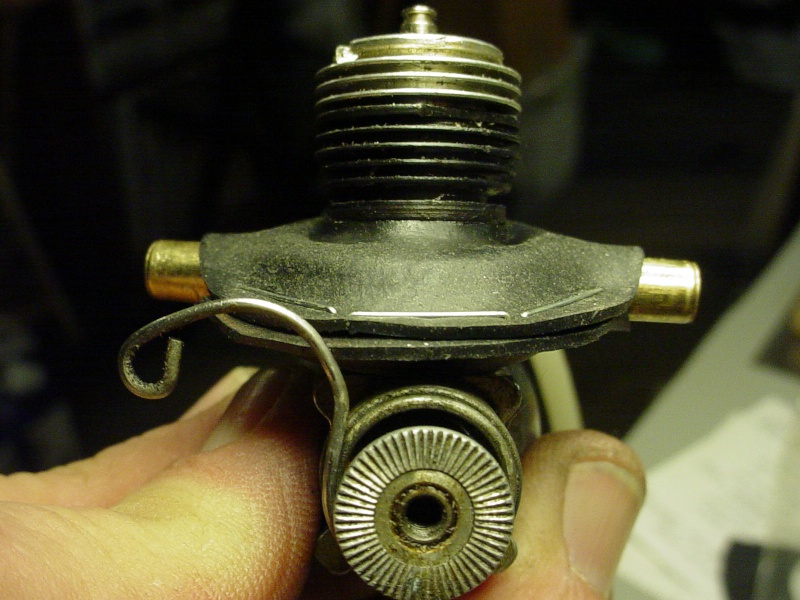

These headers are max-drilled to .205"
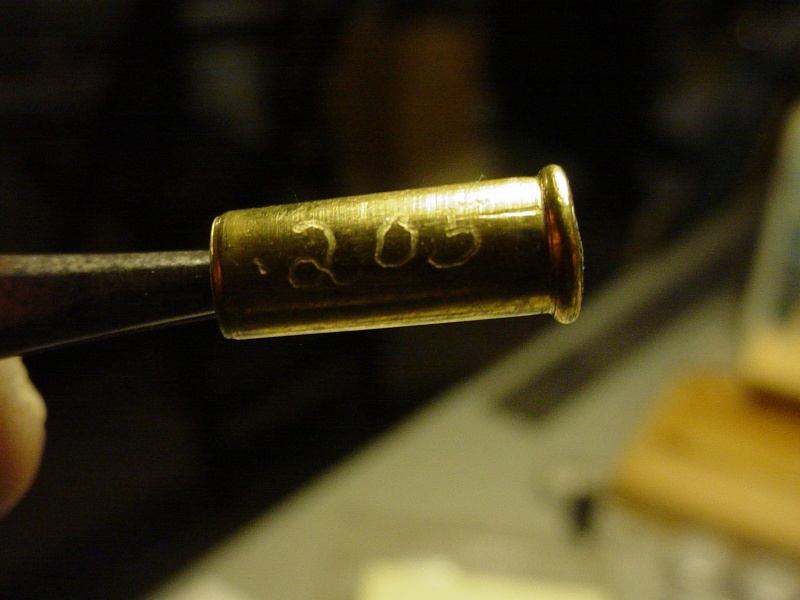

No problem when using small fuel tubing, to squirt some fuel into the pipe for an exhaust-prime.
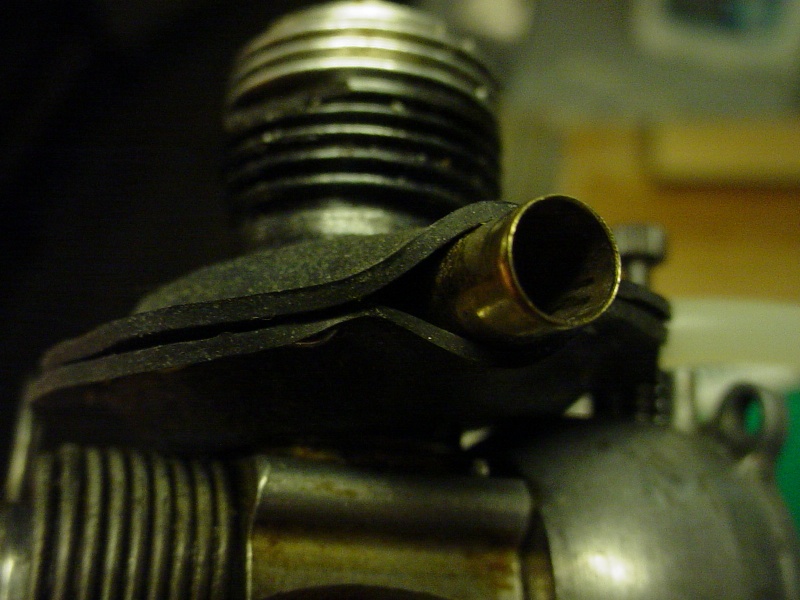


Again.. once assembled; it pushes right on over the glow-head.

I tried a different type of rubber.. (same .040" thickness) but encountered a tear when installing the inner alum. ring. so I remade the rubber-body from inner-tube (bicycle) rubber which is very tough. The two rubber discs are 1.625" dia. and the holes in the center are punched-out 7/16" dia. They are simply stapled together around the edge.. with common paper-staples.. leaving gaps where the pipes exit.
Although shown installed on a Babe Bee, this pressure-line would run back to an external hard-tank for running a horseshoe or postage-stamp backplate.



These headers are max-drilled to .205"


No problem when using small fuel tubing, to squirt some fuel into the pipe for an exhaust-prime.


Last edited by roddie on Tue Mar 21, 2023 12:02 pm; edited 1 time in total (Reason for editing : corrected the stated pipe dia. from .750" to 1.000")
 Re: a cheap sport muffler
Re: a cheap sport muffler
Roddie - it is this that matters.
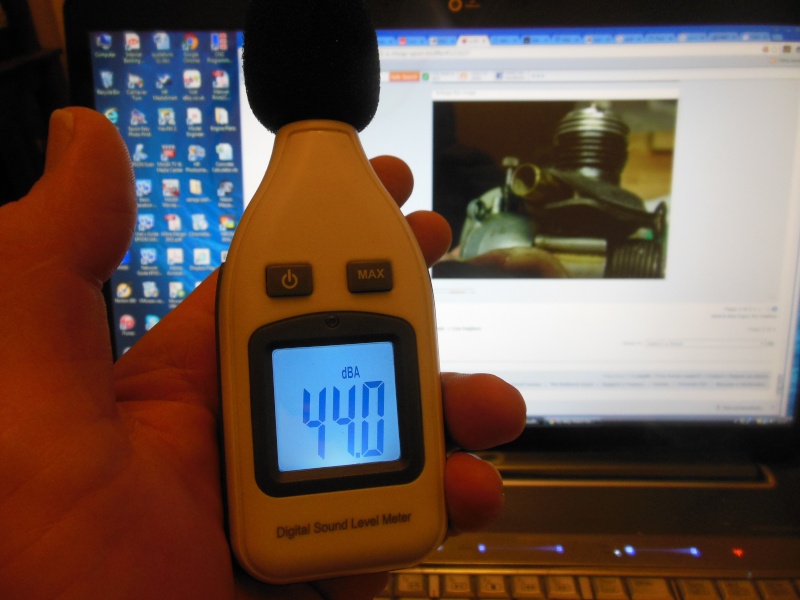
On my last visit to a club in the North - they were strictly enforcing 82db at various positions around the model before allowing flight.
So I bought one of these to check my engines, quite a few of them fail until I stuff steel wool in the exhaust (that was a tip from the club). I haven't tried it on any Bees yet.
Gone are the days - I can be deafened by screaming rug rats but the beautiful sound of IC engines is no longer acceptable!

On my last visit to a club in the North - they were strictly enforcing 82db at various positions around the model before allowing flight.
So I bought one of these to check my engines, quite a few of them fail until I stuff steel wool in the exhaust (that was a tip from the club). I haven't tried it on any Bees yet.
Gone are the days - I can be deafened by screaming rug rats but the beautiful sound of IC engines is no longer acceptable!

ian1954- Diamond Member

- Posts : 2688
Join date : 2011-11-16
Age : 70
Location : England
 Re: a cheap sport muffler
Re: a cheap sport muffler
I hope that's the one your sending me to try even though I don't have to worry about the wonderful sound of screaming bee's I am looking forward to tring it out as we had spoke before , I PROMISE NOT TO PULL A RUSTY ON YOU AND STICK YOUR MUFFLER DESIGN IN A DRAW  I WANT TO GET MY STUNTMAN 23IN THE AIR WITH THAT Madellion on it and that may will bee the test . After I test stand run just to get the hand of whats going on ! The Thankful Eric
I WANT TO GET MY STUNTMAN 23IN THE AIR WITH THAT Madellion on it and that may will bee the test . After I test stand run just to get the hand of whats going on ! The Thankful Eric 


getback- Top Poster



Posts : 10439
Join date : 2013-01-18
Age : 67
Location : julian , NC
 Re: a cheap sport muffler
Re: a cheap sport muffler
ian1954 wrote:Roddie - it is this that matters.
On my last visit to a club in the North - they were strictly enforcing 82db at various positions around the model before allowing flight.
So I bought one of these to check my engines, quite a few of them fail until I stuff steel wool in the exhaust (that was a tip from the club). I haven't tried it on any Bees yet.
Gone are the days - I can be deafened by screaming rug rats but the beautiful sound of IC engines is no longer acceptable!
I'd be very interested to know the db#'s that Cox engines average at varying distances.
A meter similar to yours (if not the same exact model) is selling on Amazon currently for less than $20.00+ shipping. It's their best-seller with a ton of reviews.
Amazon offering
I could try steel-wool (#0000-grade) stuffed pipes..
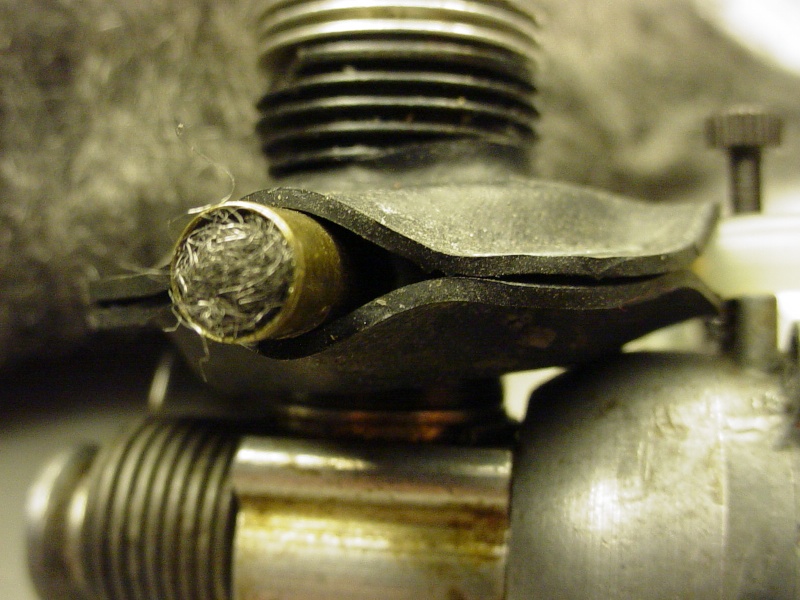
Yes Eric.. I'm putting a kit together for you. It should work on your Medallion.. but "as-is".. this muffler doesn't seem to fit between the cylinder/carb. on a Tee Dee, because of the NVA/housing being in-between. I'm thinking about designing something that would.. but it would involve a smaller inner-ring that wouldn't fit over the glow-head. Installation/removal would require removing the cylinder from the engine. That would greatly hinder swapping-out different pipes to experiment with.
I have an assortment of pipes with smaller holes drilled in them too. This one is the smallest at .144"
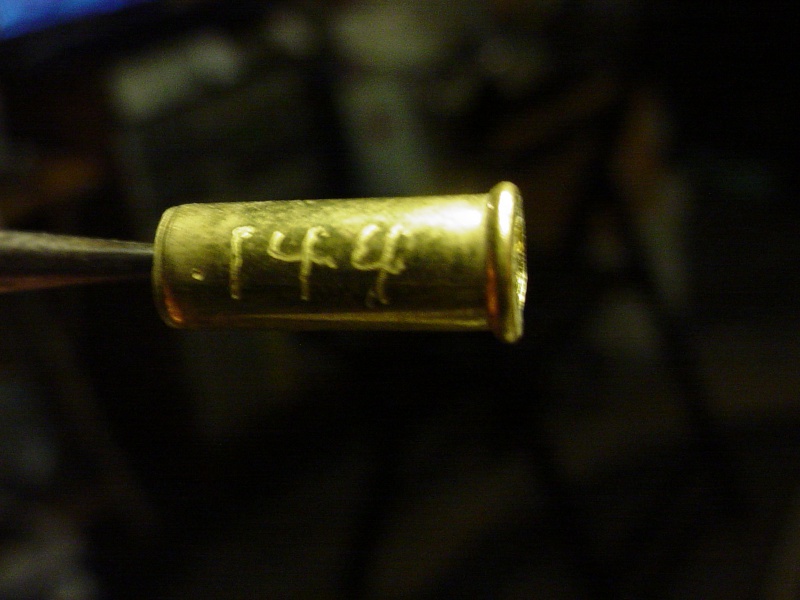
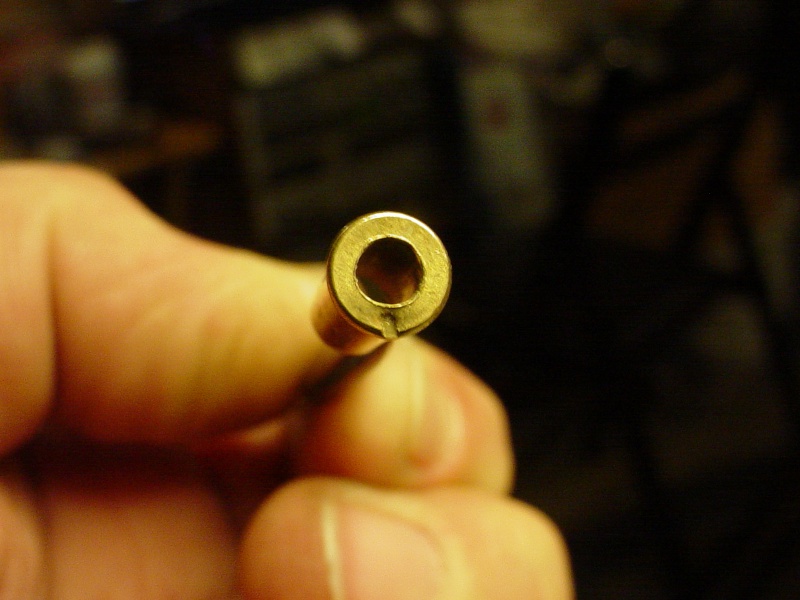
Here's the complete assortment.
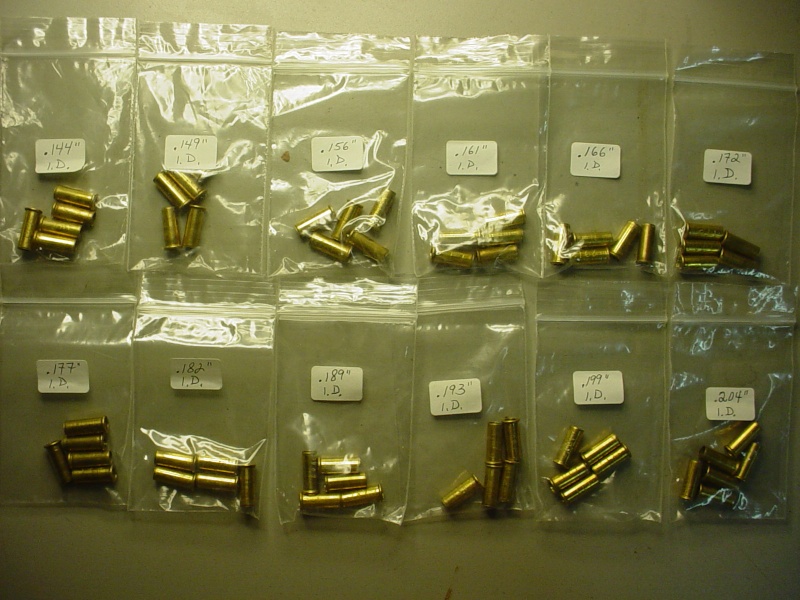
I mentioned to Rusty; the possibility of mixing different diameter dual-pipes to see if it might produce a cross-flow "scavenging" effect. For instance; installing a .204" orifice pipe 180 degrees from a .102" orifice one? It would be an interesting experiment. Who knows.. it might exhibit SPI-type performance with a non-SPI cylinder? I'm curious whether the pipe-indexing in relation to the exhaust ports on the cylinder would matter? It's easy enough to rotate the assembly while running the engine to see if it has any effect on performance. In this mode, we'd be looking more at exhaust "tuning" rather than noise-reduction.
 Re: a cheap sport muffler
Re: a cheap sport muffler
That is the same meter as mine - mine was £14.40 - free shipping - next day delivery from Amazon Prime.

ian1954- Diamond Member

- Posts : 2688
Join date : 2011-11-16
Age : 70
Location : England
 Re: a cheap sport muffler
Re: a cheap sport muffler
Eric, I'll make/send a .102" orifice pipe from a blank and include it in the kit for you to try with a .204" pipe. I reckon that you or a friend has a .22cal pistol or rifle? Save the shell-casings in case you want to drill them out to different sizes than what I'm sending you. They can't be re-loaded by law.. so most people just throw them away. I got mine at a shooting-club. I asked one of the officers first.. and he said to help myself to anything I could find on the ground or in the trash-barrel. I gathered-up a handful and put them in a coffee-cup!
 Re: a cheap sport muffler
Re: a cheap sport muffler
Ok Great I have a few 22s lying around , I am hoping it will fit the medallion , I think the carb. assy. is lower than a TD. About to get started on some rebuilding so I will catch you later , That's a pretty good assortment of 22 drilled casings  Eric
Eric 
 Eric
Eric 

getback- Top Poster



Posts : 10439
Join date : 2013-01-18
Age : 67
Location : julian , NC
 Re: a cheap sport muffler
Re: a cheap sport muffler
Just an FYI.. I'm using .22cal "long" type for my header-pipes. They have an avg. case-length of .613". "Shorts" are .421" and "Winchesters" are 1.055". The Winchester is too long for installation inside the 1.000" OD alum. ring. Shorts "could" be used for less wind-resistance I suppose. Drilling the casings out to their max ID requires a holding-fixture and a #5 (.205") drill. The casing OD is .228" (avg.).. but I found that a "B" (letter-size .238") makes clearance for swapping-out pipes much easier. This can be done without taking the muffler apart. With it "off" of the engine; just push the existing pipes inward and they will drop out through either hole in the rubber that seals the cylinder. Installing pipes takes a little "fiddling" but not what I'd call tedious. That's why I drill the holes for them .010" oversize. Once the pipes are installed, pull "outward" on them; seating the rim against the inner ring.. and hold while pushing-on over the cylinder/glow-head. This prevents the inner-rims of the pipes from snagging on the head. Once installed, the pipes won't fall out.
Here's an example of the clearance you have inside on installation (pipes fully-seated) over an .049 glow-head. Note that the pipes shown are "blanks" that haven't been drilled-out yet.
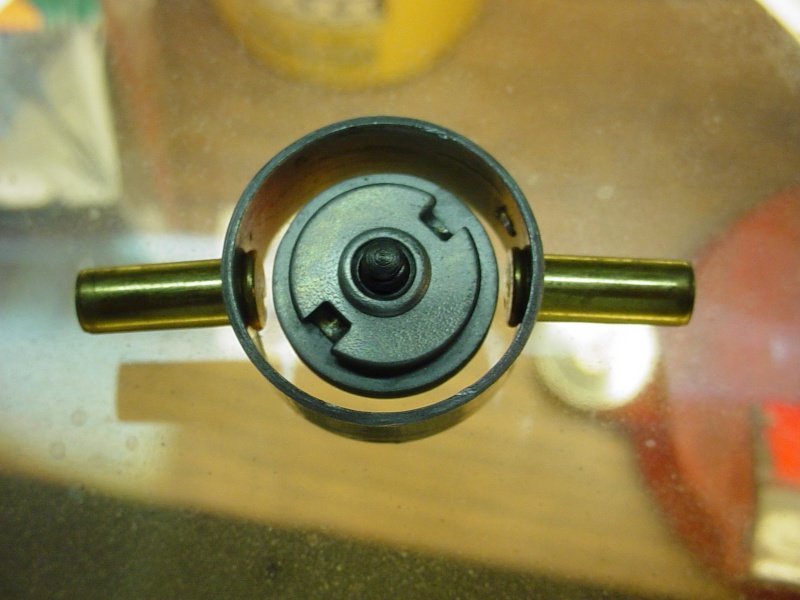
Here's an example of the clearance you have inside on installation (pipes fully-seated) over an .049 glow-head. Note that the pipes shown are "blanks" that haven't been drilled-out yet.

Last edited by roddie on Tue Mar 21, 2023 12:12 pm; edited 1 time in total (Reason for editing : Corrected stated alum. ring/pipe size from .750" to 1.000")
 Re: a cheap sport muffler
Re: a cheap sport muffler
getback wrote:Ok Great I have a few 22s lying around , I am hoping it will fit the medallion , I think the carb. assy. is lower than a TD. About to get started on some rebuilding so I will catch you later , That's a pretty good assortment of 22 drilled casingsEric

Haha... yes; the assortment of pipes I made (with ID-size etched on each) is definitely the work of a sick mind..
On the Medallion, the muffler's rubber-body could obstruct airflow to the venturi.. but it's flange/"lip" will easily flex up or down.. and be tucked behind it. Who knows.. if the rubber-part flexes "up"... it may provide a ram-air induction effect.
 The inner-ring's clearance shouldn't be a problem.
The inner-ring's clearance shouldn't be a problem.  Re: a cheap sport muffler
Re: a cheap sport muffler
Hopefully this muffler will fit Eric's .049 Medallion. It fits this DC .049 beautifully (Thank you Ian) without disassembly or obstructing the venturi.
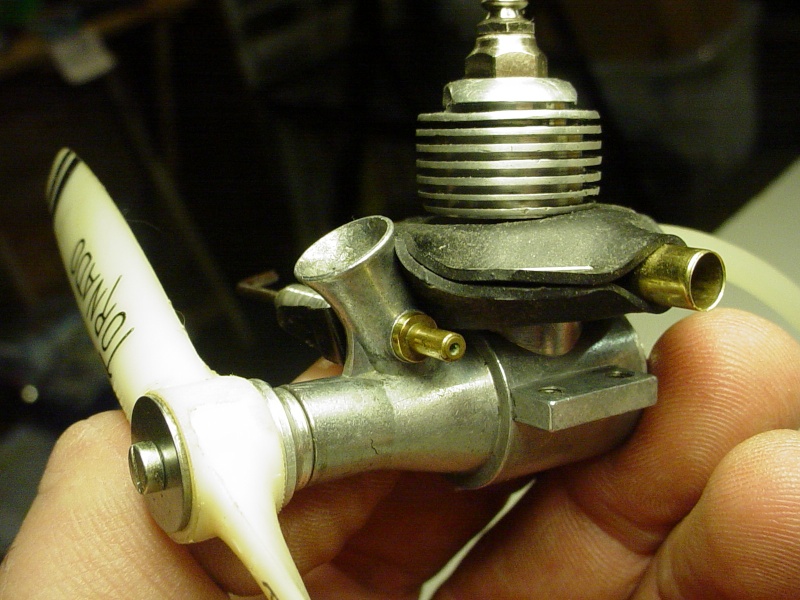

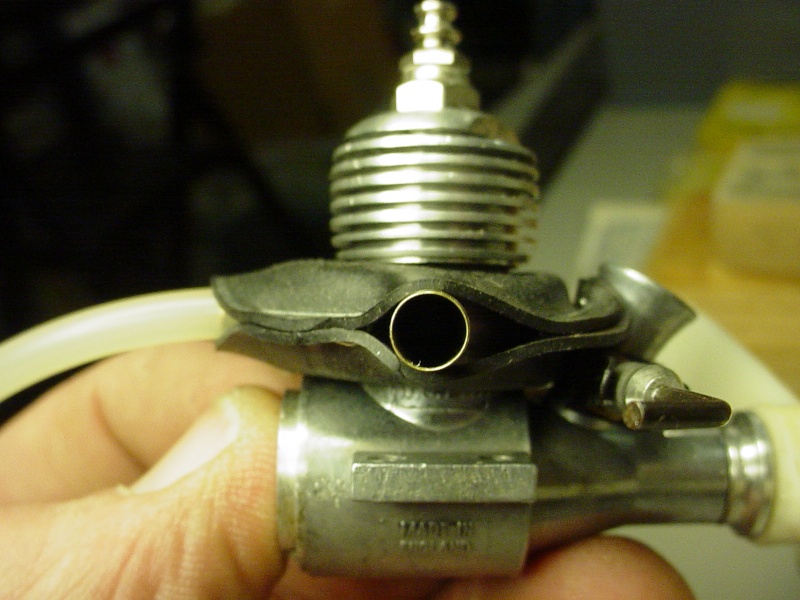
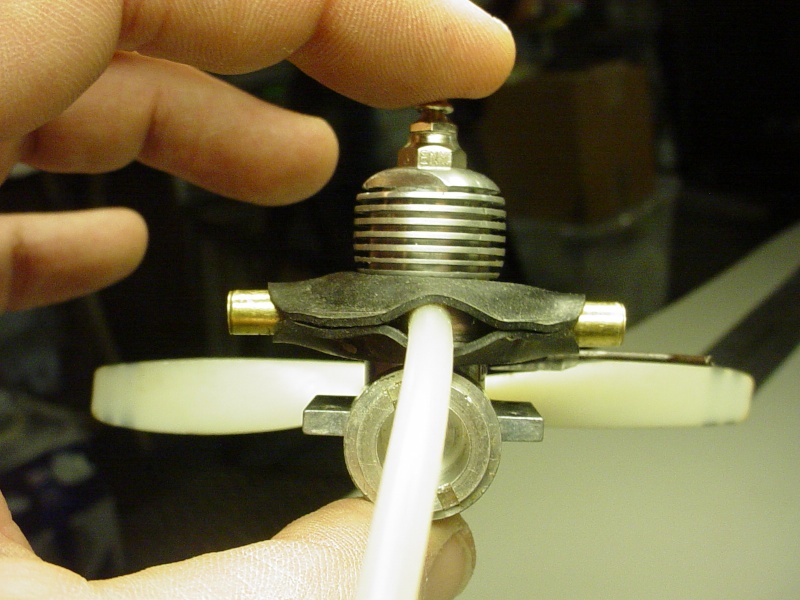
This OK Cub .049 would be hard to choke.. but would probably run fine with it.
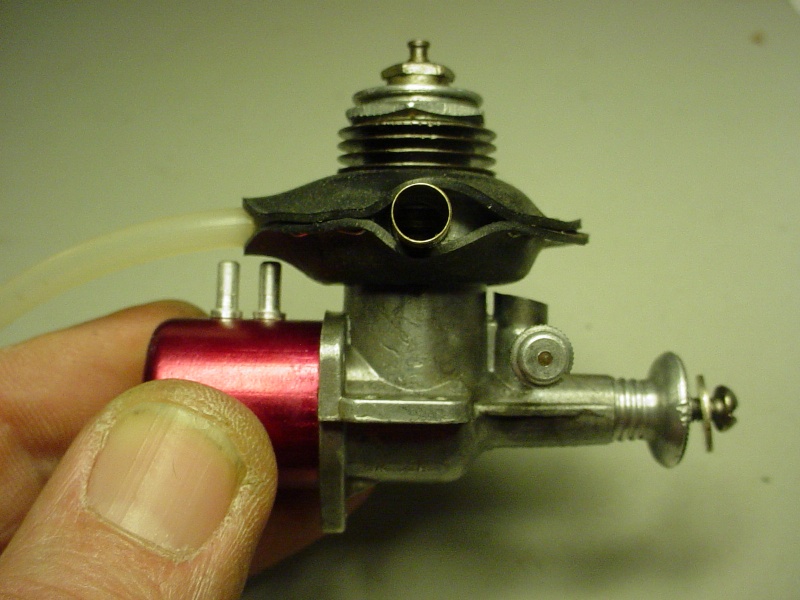
The rubber body of this expansion-chamber is stretchy. Once it's pushed-on over the cylinder; stretching the rubber by pulling at the edges where it's stapled, seats the rubber like a "boot" around the bottom of the cylinder, as well as pulling the top down below the fins on the upper-cylinder. Think of it as like putting on galoshes over you shoes.. (remember those? ) and stretching them to fit. The inner-tube type rubber that I use is butyl-rubber which is fairly resistant to heat and tearing. I haven't found it to be adversely affected by glow-fuel.. (I have 10 year-old fuel-soaked mufflers that show no signs of deterioration.) The staples hold the two rubber discs together extremely well.. and the oil from the fuel keeps them from rusting. I've twisted/stretched the rubber open at the center-holes to install the inner alum. ring with no signs of splitting or staples pulling-out.. and the staples are very close to the edge.
) and stretching them to fit. The inner-tube type rubber that I use is butyl-rubber which is fairly resistant to heat and tearing. I haven't found it to be adversely affected by glow-fuel.. (I have 10 year-old fuel-soaked mufflers that show no signs of deterioration.) The staples hold the two rubber discs together extremely well.. and the oil from the fuel keeps them from rusting. I've twisted/stretched the rubber open at the center-holes to install the inner alum. ring with no signs of splitting or staples pulling-out.. and the staples are very close to the edge.
Not much weight to it either.
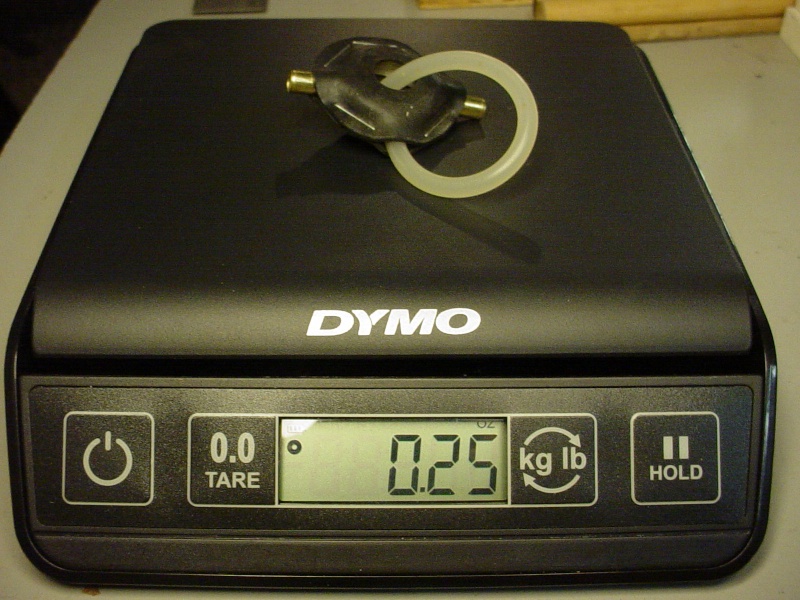




This OK Cub .049 would be hard to choke.. but would probably run fine with it.

The rubber body of this expansion-chamber is stretchy. Once it's pushed-on over the cylinder; stretching the rubber by pulling at the edges where it's stapled, seats the rubber like a "boot" around the bottom of the cylinder, as well as pulling the top down below the fins on the upper-cylinder. Think of it as like putting on galoshes over you shoes.. (remember those?
Not much weight to it either.

 Re: a cheap sport muffler
Re: a cheap sport muffler
Roddie!
I now realize that I made contact with you long ago, when I saw a video where you showed the progress of a Cox 049 engine and you controlled with a needle speed!
We made contact via email, remember!?, I am happy to greet you hereby !, thanks for sharing your knowledge.
Remember me?
Greetings, Mauricio,.
I now realize that I made contact with you long ago, when I saw a video where you showed the progress of a Cox 049 engine and you controlled with a needle speed!
We made contact via email, remember!?, I am happy to greet you hereby !, thanks for sharing your knowledge.
Remember me?
Greetings, Mauricio,.


MauricioB- Top Poster

- Posts : 3712
Join date : 2016-02-16
Age : 53
Location : ARG
 Re: a cheap sport muffler
Re: a cheap sport muffler
MauricioB wrote:Roddie!
I now realize that I made contact with you long ago, when I saw a video where you showed the progress of a Cox 049 engine and you controlled with a needle speed!
We made contact via email, remember!?, I am happy to greet you hereby !, thanks for sharing your knowledge.
Remember me?
Greetings, Mauricio,.
Hi Mauricio! Yes.. I remember. You have some very nice model airplanes my friend!
This is the vid that shows my 1st-generation muffler being used with the "Ace" (Ralph Cooney designed) throttle for Bee-style Cox engines.
I've never tried editing a video..
YouTube link
The instructions that came with the throttle recommended the use of a muffler to achieve lower rpm's. The dual-pipes on this muffler are not made from .22cal shell-casings. They came from a plumbing-parts package that included a flared brass tube measuring .220" OD/.185" ID.. but were limited to flowing through that "fixed" .185" dia. orifice. My current design has the option to flow up to a .205" diameter orifice by using the shell-casings drilled out to their max. ID. This size I have calculated to be equal in area to a #2 Cox .049 cylinder's exhaust-port.. which would be minimally-restrictive in a dual-pipe configured muffler.
I have not tried running smaller-orifice pipes yet. At some point of exhaust-restriction, there could be blow-by through the areas where the rubber body seats. If so; any further restriction of the pipes would have no effect. We may find that restricting the flow may not provide any noise-reduction benefits.. while at the expense of reduced performance.
I think that running dual-pipes 180 degrees apart, provides for better performance experimentation. As I previously mentioned; "cross-flow" tests using different sizes on opposite sides.. and/or rotation of the muffler to see if this alters timing?
Then there's a noise-reduction test that "Ian" turned me on to. Adopting it for my muffler-design would involve stuffing a pair of full-flowing pipes with #0000 (super-fine) steel-wool. No way to accurately measure the back-pressure though. It would depend on how tightly the pipes were stuffed. Would the steel-wool blow-out immediately? Maybe a drop of thin CA would hold the steel-wool in the pipe?
The most difficult part of making this muffler is accurately drilling the holes for and "in" the pipes. For one; you really need a machinist's drill index assortment. Most people don't have one.. but you can get by with a single "B" (.238") size for drilling the inner alum. ring holes that accept the pipes. This is best accomplished using a drill-press and fixture of some sort to hold the ring. An ideal fixture would index the ring 180 degrees for drilling the 2nd hole by means of a "pin" for the 1st one to fit over. I hold my rings with locking-pliers fitted with rubber pads.. but I want to make something better than that.
The shell-casings (pipes) are tedious to drill-out. I used a piece of plywood with a hole pre-drilled for a press-fit of the shell-casing. The problem is.. the casing will start to slip and spin-out when drilling, as the hole wears after drilling-out a couple of pipes.
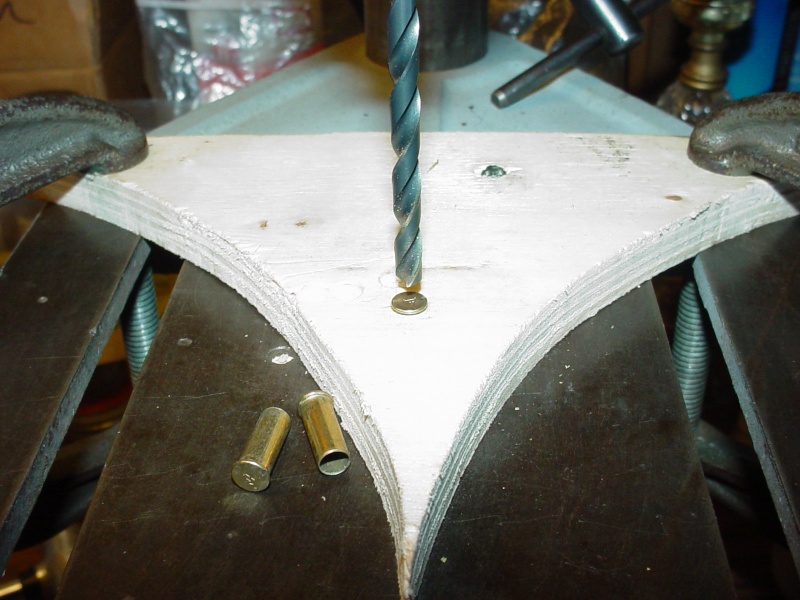
A better solution would be a small alum. block having a .228" diameter hole for the casing to drop into (#1 drill) with a side-hole tapped for a small set-screw.
I'm going to make better fixtures soon.. along with a more accurate way to cut the "length" of the ring. I've been using a plumbing-type pipe-cutter thus far. A band/cut-off saw would be ideal.. but I can't justify the cost. I may be able to use the one at the machine-shop where I used to work.
 Re: a cheap sport muffler
Re: a cheap sport muffler
PUNCH THE CASINGS!!!
Get a hardened steel pin punch with a nice clean square end that can slip inside the casing and set the casing on some end grain wood. Harder wood will be better. Hit it with a hammer.
Be amazed at how clean the hole is.
Phil
Get a hardened steel pin punch with a nice clean square end that can slip inside the casing and set the casing on some end grain wood. Harder wood will be better. Hit it with a hammer.
Be amazed at how clean the hole is.
Phil

pkrankow- Top Poster

- Posts : 3025
Join date : 2012-10-02
Location : Ohio
 Re: a cheap sport muffler
Re: a cheap sport muffler
If you read-back though this thread, you'll find where I mention tapping pressure from this muffler-design. I got to thinking about application a little more in-depth today.
I have preferred small (6-10cc) conventional "wedge-tanks" on my 1/2A C/L models. I'd like some feedback on a hypothetical idea.
I don't know if muffler-pressure will work.. or is normally applied to a wedge-tank.. but I thought about a connection that might work well. If I connect the pressure-line to the "bottom-vent" and plug the "top-vent", it should initially prevent the fuel from being aerated with air-bubbles. Once the needle is optimized for flight.. and the successive walk to the handle, the fuel-level will drop in the tank. Once "airborne; the fuel will move toward the wedge.. and away from "both" vent-tubes. (correct?) Assuming so; maneuvering into inverted-flight should not introduce any air-bubbles into the fuel.
The muffler-pressure is quite variable with my design.. depending on pipe-configuration. The "main" exhaust is variable through the use of single/dual header(s).. with a variety of different openings to control flow as well as cross-flow. The pressure-tap consists of a small/single-flared tube not unlike a conventional muffler-pressure tap. The pressure that it poses on the tank will be directly affected by the total-pressure within the muffler when the engine is running.
Here's a photo of a dual-pipe chamber with a muffler-pressure feed.

Here's a photo of how the chamber with dual-pipes fits-around a Cox .049 cylinder .

A single-pipe should work with a muffler-pressure tap.. perhaps with favorable results. I'm hoping that this concept will add a new dimension to tuning our engines for a particular purpose.
I plan on trying multiple configurations this season. Granted; there are many variables involved.. but I'll make an attempt to isolate them by notating the test-cylinder's porting, pipe-configuration (IE: dual/single/flow-diameter) and orientation of pipe(s) to the exhaust-ports vs. the orientation of the pressure-tap (in degrees from the main pipe(s)/ports). I feel that this will all have a bearing on performance. This will take some time and trial.. but I think that it might be worthwhile. Performance enhancements through exhaust-flow/scavenging have been realized. Why not apply it to our little engines?
I have preferred small (6-10cc) conventional "wedge-tanks" on my 1/2A C/L models. I'd like some feedback on a hypothetical idea.
I don't know if muffler-pressure will work.. or is normally applied to a wedge-tank.. but I thought about a connection that might work well. If I connect the pressure-line to the "bottom-vent" and plug the "top-vent", it should initially prevent the fuel from being aerated with air-bubbles. Once the needle is optimized for flight.. and the successive walk to the handle, the fuel-level will drop in the tank. Once "airborne; the fuel will move toward the wedge.. and away from "both" vent-tubes. (correct?) Assuming so; maneuvering into inverted-flight should not introduce any air-bubbles into the fuel.
The muffler-pressure is quite variable with my design.. depending on pipe-configuration. The "main" exhaust is variable through the use of single/dual header(s).. with a variety of different openings to control flow as well as cross-flow. The pressure-tap consists of a small/single-flared tube not unlike a conventional muffler-pressure tap. The pressure that it poses on the tank will be directly affected by the total-pressure within the muffler when the engine is running.
Here's a photo of a dual-pipe chamber with a muffler-pressure feed.

Here's a photo of how the chamber with dual-pipes fits-around a Cox .049 cylinder .

A single-pipe should work with a muffler-pressure tap.. perhaps with favorable results. I'm hoping that this concept will add a new dimension to tuning our engines for a particular purpose.
I plan on trying multiple configurations this season. Granted; there are many variables involved.. but I'll make an attempt to isolate them by notating the test-cylinder's porting, pipe-configuration (IE: dual/single/flow-diameter) and orientation of pipe(s) to the exhaust-ports vs. the orientation of the pressure-tap (in degrees from the main pipe(s)/ports). I feel that this will all have a bearing on performance. This will take some time and trial.. but I think that it might be worthwhile. Performance enhancements through exhaust-flow/scavenging have been realized. Why not apply it to our little engines?
 Re: a cheap sport muffler
Re: a cheap sport muffler
If you can effectively seal the fuel tank then you should try tapping the crankcase for pressure. You get super steady fuel flow

fit90- Diamond Member

- Posts : 1341
Join date : 2011-08-11
Location : Naples, Florida
 Re: a cheap sport muffler
Re: a cheap sport muffler
fit90 wrote:If you can effectively seal the fuel tank then you should try tapping the crankcase for pressure. You get super steady fuel flow
I know that crankcase-tapping for pressure has been accomplished with Cox reedies Bob.. but this concept is something that I'd like to explore through exhaust-pressure. My muffler's aren't hard to make.. and I feel that there's a lot more experimentation that can be done.. without having to drill-out the case. My muffler-design is installed without taking the engine apart at all. All mods are performed on the muffler alone.. independent of the engine... unless a different cylinder/porting is chosen to test.
 Re: a cheap sport muffler
Re: a cheap sport muffler
Roddie,
I definitely get the experimenting and learning part of playing with our little engines. I think that is where most of the fun lies. We are constantly coming up with new and unique ways to accomplish the same tasks. I look for ward to following your post and seeing how it goes.
Bob
I definitely get the experimenting and learning part of playing with our little engines. I think that is where most of the fun lies. We are constantly coming up with new and unique ways to accomplish the same tasks. I look for ward to following your post and seeing how it goes.
Bob

fit90- Diamond Member

- Posts : 1341
Join date : 2011-08-11
Location : Naples, Florida
Page 2 of 5 •  1, 2, 3, 4, 5
1, 2, 3, 4, 5 
 Similar topics
Similar topics» NorVel .061 muffler wanted...cheap!
» Super sport 049
» Why are Tee Dee 010 so expensive?
» Cox Sandblaster clean-up
» RC flying on the cheap........................
» Super sport 049
» Why are Tee Dee 010 so expensive?
» Cox Sandblaster clean-up
» RC flying on the cheap........................
Page 2 of 5
Permissions in this forum:
You cannot reply to topics in this forum

 Rules
Rules








